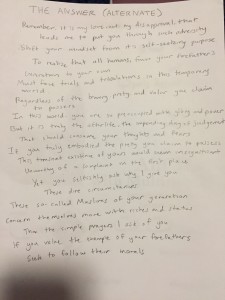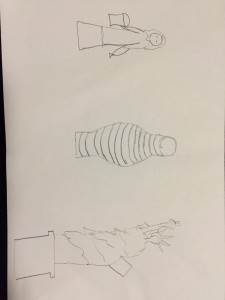First Four Creative Responses
In the seminar, we discussed at length the abstract nature of religion in general and Islam in particular due to the vast multitude of variation within different sects of the religion. For instance, the two main sects Shi’a and Sunni, but also various other groups who believe in mysticism, such as the Sufis. Furthermore, various groups that are in some way distinct from one another have branched from the two main sects. This very diversity, I believe, forces one to contextualize his or her approach of the religion, as it cannot be thought of as one monolithic entity. However, what I find moving is that despite these differences in the interpretation of the religion, the one commonality that ties all Muslims is the belief that there is no god but God and that the Prophet Muhammad is his messenger. For this reason, in one of my creative responses, I chose to represent the religion of Islam as a tree, with the Qur’an, which is widely held to be the central sacred religious text, despite the many different forms of Islam that are practiced, depicted at the base, or trunk, of the tree. Furthermore, I represented the two main sects of Islam—Sunni and Shi’a, as branches of the tree, with Baha’i and Ahmadi branching from Shi’ite and Sunni Islam, respectively. In order to demonstrate the link that ties all these forms of Islam together, I wrote, in Arabic, “There is no god but God, and Muhammad (peace be upon him) is his messenger”. In this sense, my response depicts both the remarkable diversity within Islam and the crucial common belief that ties Muslims together.
One of the topics addressed in this seminar which I found extremely interesting was the multitude of ways in which the hijab is perceived by others. Many fail to take into account the hijab’s cultural context, immediately and simplistically assuming it to contribute to the oppression of women in Muslim countries, blaming such conditions on the religion itself. However, one must recognize that the hijab holds numerous contexts, for example, in terms of politics, such as the requirement that women wear hijab in countries like Saudi Arabia, Iran, and Afghanistan, and the fact that the veil is used as a mark of status in Mediterranean cultures. While the necessity of the hijab, as well as whether it is liberating or oppressive, are points of contention even within Islamic societies, it seems that the media projects its generally negative view of the religion, categorizing Muslims as a violent, foreign, or even inferior “other”, onto our perception of hijab. This notion intrigued me, and inspired my creative response, in which I drew a Muslim woman wearing a hijab, and outsiders surrounding her. Next to these “outsiders” I wrote in words that embodied what one, paying attention solely to the media’s representation of veiled women, would feel or think about this Muslim woman. Above the woman herself, I wrote in words that would describe the way the woman herself may feel about her hijab, in contrast to how others would perceive her. Thus, in my response, I aimed to not only contrast public opinion of the hijab with one’s personal opinion, but to also address the media’s categorization of Muslims as “the other”, a concept which was also discussed in class.
When I read Iqbal’s poem, “The Complaint”, although I enjoyed the way it was structured, like a dialogue between a devout believer of Islam and his God, I found that the “answer” to the complaint, which Iqbal presumably intends to appear as a message from God, only addressed the idea that a man who complains of his circumstances is selfish, due to the fact that he is not as pious as his predecessors. Although the poem may have functioned more as a call to reform in the political sense, I still found it odd that Iqbal failed to address the all-important fact that one who has faith in God should not complain about his or her circumstances in the concrete sense for a variety of reasons: firstly, when a person faces suffering, it makes more sense for him or her to view it as tribulation sent from God, in order to test the person’s faith, rather than undeserved punishment. Furthermore, people who are truly pious value their relationship with God and ultimately, the afterlife, over their conditions in the material world, which the narrator of the complaint seemed to prioritize. For these reasons, I decided to write an alternate “answer” in the form of a poem to Iqbal’s complaint as I imagined it would be. In this poem, I aimed to retain the original “call to reform” that Iqbal seemed to address towards Muslims of today, while still altering it in order to call attention to the fact that one’s desire to adhere to Islam should transcend one’s own self-interest.
When I read The Suns of Independence, I was immediately intrigued by how the author presented a contrast between the cultural norms, especially evident through the superstition and mysticism evident throughout the novel, and the materialistic politicized world that has assumed power in modern times. I found that, in this novel in particular, cultural norms, in particular, Salimata’s brutal excision ritual, were labelled as regressive, having lost their value and importance. This notion was also enforced by the character of Fama, who belonged to a once-powerful tribe but is now regarded as powerless due to the power of the nation-state and diminishing significance of culture and tribalism. This novel, for these reasons, presented the notion of the West, a society that embodies knowledge, education, political power, and for the most part, secularism, in opposition to the East, which embodies tradition, culture in a way many would find regressive. This theme of East vs. West was prevalent throughout this seminar, most notably, in story of “The Saint’s Lamp” in which Ismael, the protagonist, leaves his village to go to university in the West, and soon comes to the realization that culture and logic can coexist, and reinforce one another. To illustrate these themes in my creative response, I decided to draw a lamp (representing the one in “The Saint’s Lamp”) in the middle of the paper as a bridge between culture and wisdom/logic. On one side, in order to depict traditional culture, I chose to portray the scene from The Suns of Independence in which Salimata engages in superstitious practices in an attempt to stimulate her ability to conceive. On the other, I portrayed symbols that embodied Western culture.


